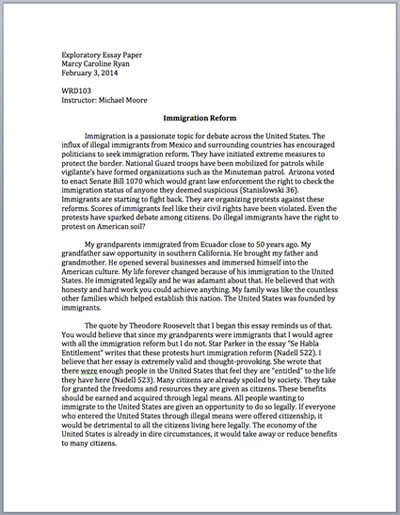Here’s a possible approach to a Multimodal Exploratory Project
Genre: Multimodal Exploratory Project
Audience: Instructor, classmates, possible future readers
Purposes: To explore your issue; to explain your understanding of the issue; to engage readers/participants with kairotically effective texts
If I asked you to choose an issue — immigration reform, say, or the relative merits of kale smoothies — to explore it and to explain your understanding of the issue in an academic essay, I suspect that you would know the general introduction-body-conclusion parameters of that genre and you would compose something like this:
 For our Multimodal Exploratory Project in our class, however, I am asking you to consider something completely different: rather than an essay composed of text, can you imagine, instead:
For our Multimodal Exploratory Project in our class, however, I am asking you to consider something completely different: rather than an essay composed of text, can you imagine, instead:
- How to represent your understanding of the issue, why it matters to you, and why it should matter to us? I am purposefully not providing you with examples, options, and possible materials; use your imagination
- Why you might want us to view your exploration and your understanding in that way?
- What process you would need to engage in order to achieve the successful completion of such a project?
Our approach and your deadlines:
- For Tuesday, brainstorm and then commit to your issue and project. Include in your workshop statement how and why you are choosing the method and materials that you plan to use.
- Sunday: post your first project iteration. Include in your post a statement describing what is going well — what you like about the project — and what is not going well.
- By Tuesday, before class, respond to two classmates’ project iterations; see editorial peer-review criteria and guidelines [link]
- For Tuesday, before class, post your final project iteration. Include in your post a reflective statement that discusses your original goals, and how well you achieved them; your planned process, and how well you followed it; the intended rhetorical effects of your materials, and the steps you took to achieve those effects. [example]
[Reflective note] you have some options on that reflective statement — I’m usually thinking ahead for them at this point for good portfolio materials — but since this is one unit in a longer project, we can organize a series of task reflections, one at the end of the entire project, and they’d be in great reflective shape for the portfolio. A fuller version might look like this:
- What, specifically, is this piece trying to accomplish—above and beyond satisfying the basic requirements outlined in the task description? In other words, what work does, or might, this piece do? For whom? In what contexts?
- What specific rhetorical, material, methodological, and technological choices did you make in service of accomplishing the goal(s) articulated above? Catalog, as well, choices that you might not have consciously made, those that were made for you when you opted to work with certain genres, materials, and technologies.
- Why did you end up pursuing this plan as opposed to the others you came up with? How did the various choices listed above allow you to accomplish things that other sets or combinations of choices would not have?
- Who and what played a role in accomplishing these goals?
The [example] responds to that version.
